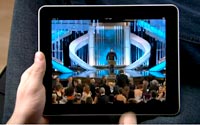 When it comes to watching entertainment
programming, it turns out size doesn’t matter as much as people previously thought (or hoped).
When it comes to watching entertainment
programming, it turns out size doesn’t matter as much as people previously thought (or hoped).
According to a new study conducted by Chadwick Martin Bailey (CMB), consumers are using
their tablets and smartphones to stream video programming at an increasing rate, and they’re doing it in their homes, where televisions are available. According to the survey of nearly 1,500
consumers, 58% of people who viewed programming on a tablet did so in their homes -- and of these, 63% did so even though the program they were watching was available on their televisions.
“The big media companies have been comforted in this notion that the biggest available screen is always going to win in any situation,” Peter Fondulas, founder of Fondulas Strategic
Research, which worked on the project with CMB, tells Marketing Daily. “That may have been true a while ago, but people have become more open to devices and may even prefer [smaller
screens] in some situations.”
advertisement
advertisement
The survey found significant members of all demographics have watched video programming through a device other than their televisions. While 74% of
consumers ages 16-29 had watched programming online, 39% of consumers 50-75 had also watched a television program or movie online. And their preferred method of watching such programming is either
through a network Web site (27%) or Netflix (24%). Only 12% of consumers said they watched through their TV provider’s Web portal (such as Comcast’s Xfinity.com).
Such findings
could have serious repercussions as the cable and satellite industries work to continue their business models in the new era of Internet-connected television. According to the study, 43% of consumers
said they’re likely to cut back on cable spending in the next year.
However, the companies’ greatest fear (consumers cutting the cord entirely and opting for an Internet-only
model) is less likely. Only 3% said they’d cut their cable entirely. More likely, consumers will be looking to “shave” services, such as cutting premium and non-premium channels,
removing HD boxes and cutting down the number of boxes in their houses.
“The people that we see shaving their pay TV service are in essence creating their own a la carte plan,” Jon
Giegengack, a director at CMB, tells Marketing Daily. “My own hunch is that pay TV will have to switch to a model more like that. as there’s more attrition.”
With
the inevitability that more people will look to the Internet to watch television and movie programming (particularly with more Internet-connected televisions in the home), the opportunity is wide open
for a company to come in with a different model that appeals to consumers’ individual tastes, Giegengack says.
“One of the barriers we found [to cord shaving] was the ambiguity of
what the options are and the services [consumers] have,” he says. “There’s this increasing group of people who are on deck and know that there are better of options available, but
haven’t yet cut the service.”
The company that does succeed will likely have to be strong on the three fronts that consumers said were important to them: streamable content
(as opposed to owned content), a wide variety of programming available and, most of all, ease of use. “Lots of companies are working hard at this, and it’s only a matter of time
before someone does,” Fondulas says.